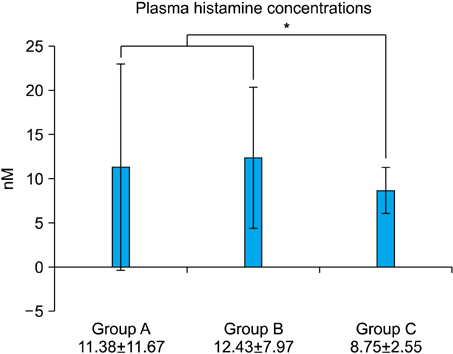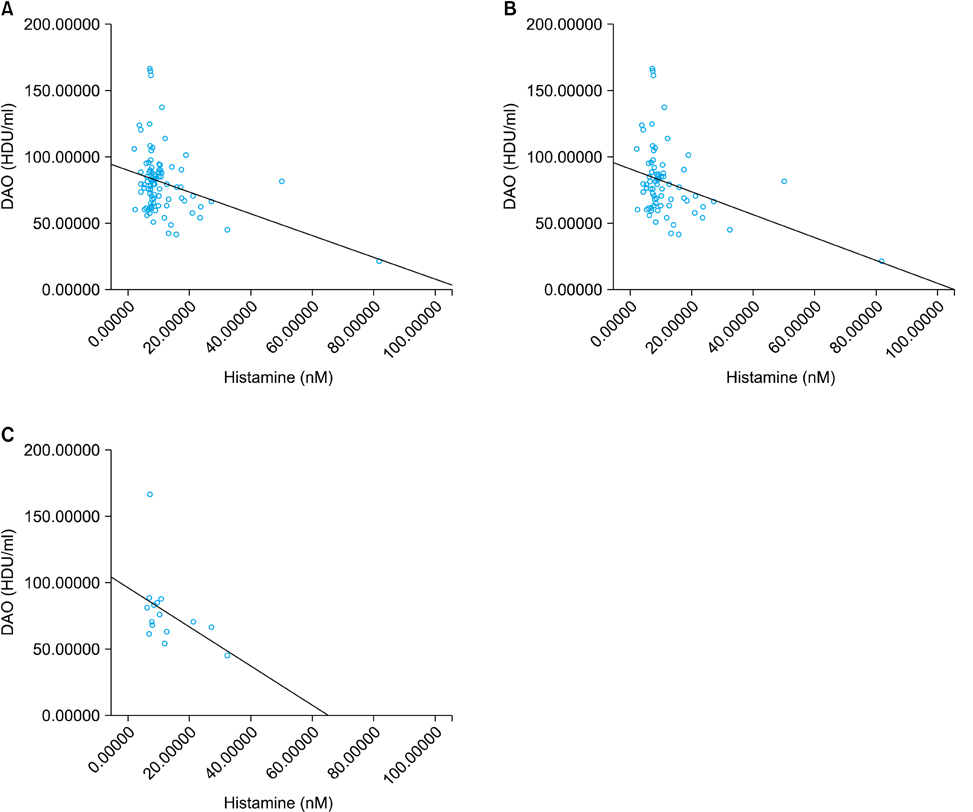Ann Dermatol.
2013 May;25(2):189-195. 10.5021/ad.2013.25.2.189.
Lack of Association of Plasma Histamine with Diamine Oxidase in Chronic Idiopathic Urticaria
- Affiliations
-
- 1Department of Dermatology, Kangnam Sacred Heart Hospital, College of Medicine, Hallym University, Seoul, Korea. dermap@daum.net
- KMID: 2171787
- DOI: http://doi.org/10.5021/ad.2013.25.2.189
Abstract
- BACKGROUND
Chronic idiopathic urticaria (CIU) is considered a complex and multifactorial disease. Excessive histamine intake may induce an attack of urticaria. The main enzyme for histamine metabolism is diamine oxidase (DAO).
OBJECTIVE
Plasma histamine concentrations and DAO activities were evaluated to determine whether there are abnormalities in the histamine metabolism of CIU patients.
METHODS
Seventy-five CIU patients and twenty-five healthy control subjects were included in the study. Blood was taken from all subjects to measure plasma levels of the histamine and DAO.
RESULTS
Mean plasma histamine levels were significantly higher in CIU patients (11.59+/-10.98 nM) than in the control subjects (8.75+/-2.55 nM) (p=0.04). Mean DAO activities were lower in patients of CIU (80.86+/-26.81 histamine degrading unit [HDU]/ml) than in the controls (81.60+/-9.67 HDU/ml), but without significant difference. In 15 CIU patients with gastrointestinal symptoms, the mean histamine concentration was higher (12.43+/-7.97 nM) and DAO activity was lower (77.93+/-27.53 HDU/ml) than in the remaining 60 CIU patients without gastrointestinal symptoms (11.38+/-11.67 nM and 81.58+/-26.82 HDU/ml), without significant difference. The relationship between DAO activity and plasma histamine concentrations showed a significant negative linear value (p=0.001). There were no significant relationships between plasma histamine concentrations and symptom severity score.
CONCLUSION
In CIU patients, a high plasma histamine concentration may not be explained by DAO activity. CIU patients with gastrointestinal (GI) symptoms showed no significantly lower DAO activity. Larger group studies are required to elucidate the relationship between plasma histamine concentrations and DAO activity, especially of CIU patients with GI symptomsto understand the difference in CIU patients with and without GI symptoms.
MeSH Terms
Figure
Cited by 2 articles
-
Effect of Different Cooking Methods on Histamine Levels in Selected Foods
Bo Young Chung, Sook Young Park, Yun Sun Byun, Jee Hee Son, Yong Won Choi, Yong Se Cho, Hye One Kim, Chun Wook Park
Ann Dermatol. 2017;29(6):706-714. doi: 10.5021/ad.2017.29.6.706.A Histamine-Free Diet Is Helpful for Treatment of Adult Patients with Chronic Spontaneous Urticaria
Jee Hee Son, Bo Young Chung, Hye One Kim, Chun Wook Park
Ann Dermatol. 2018;30(2):164-172. doi: 10.5021/ad.2018.30.2.164.
Reference
-
1. Greaves M. Chronic urticaria. J Allergy Clin Immunol. 2000. 105:664–672.
Article2. Kaplan AP. Wolff K, Goldsmith LA, Katz SI, Gilchrest BA, Paller AS, Leffell DJ, editors. Urticaria and angioedema. Fitzpatrick's dermatology in general medicine. 2008. 7th ed. New York: McGraw-Hill Medical;330–343.3. Bodmer S, Imark C, Kneubühl M. Biogenic amines in foods: histamine and food processing. Inflamm Res. 1999. 48:296–300.
Article4. Choi JH, Park CW, Lee CH. A study of histamine content in food in Korea. Korean J Dermatol. 2007. 45:768–771.5. Kanny G, Moneret-Vautrin DA, Schohn H, Feldman L, Mallie JP, Gueant JL. Abnormalities in histamine pharmacodynamics in chronic urticaria. Clin Exp Allergy. 1993. 23:1015–1020.
Article6. Reese I, Zuberbier T, Bunselmeyer B, Erdmann S, Henzgen M, Fuchs T, et al. Diagnostic approach for suspected pseudoallergic reaction to food ingredients. J Dtsch Dermatol Ges. 2009. 7:70–77.
Article7. Silla Santos MH. Biogenic amines: their importance in foods. Int J Food Microbiol. 1996. 29:213–231.
Article8. Schwelberger HG. Histamine intolerance: a metabolic disease? Inflamm Res. 2010. 59:Suppl 2. S219–S221.
Article9. Pollock I, Murdoch RD, Lessof MH. Plasma histamine and clinical tolerance to infused histamine in normal, atopic and urticarial subjects. Agents Actions. 1991. 32:359–365.
Article10. Petersen J, Drasche A, Raithel M, Schwelberger HG. Analysis of genetic polymorphisms of enzymes involved in histamine metabolism. Inflamm Res. 2003. 52:Suppl 1. S69–S70.
Article11. Smith CH, Soh C, Lee TH. Cutaneous histamine metabolism in chronic urticaria. J Allergy Clin Immunol. 1992. 89:944–950.
Article12. Rokkas T, Vaja S, Taylor P, Murphy GM, Dowling RH. Is the intestine the sole source of heparin-stimulated plasma diamine oxidase? Acute effects of jejunectomy, ileectomy and total enterectomy. Digestion. 1990. 46:Suppl 2. 439–446.
Article13. Breneman D, Bronsky EA, Bruce S, Kalivas JT, Klein GL, Roth HL, et al. Cetirizine and astemizole therapy for chronic idiopathic urticaria: a double-blind, placebo-controlled, comparative trial. J Am Acad Dermatol. 1995. 33:192–198.
Article14. Kulthanan K, Jiamton S, Thumpimukvatana N, Pinkaew S. Chronic idiopathic urticaria: prevalence and clinical course. J Dermatol. 2007. 34:294–301.
Article15. Maintz L, Novak N. Histamine and histamine intolerance. Am J Clin Nutr. 2007. 85:1185–1196.
Article16. Schwelberger HG. Falus A, Grosman N, Darvas Z, editors. Diamine oxidase (DAO) enzyme and gene. Histamine : biology and medical aspects. 2004. Basel, Switzerland: Karger, Budapest, Hungary: SpringMed Pub.;43–52.17. Zimatkin SM, Anichtchik OV. Alcohol-histamine interactions. Alcohol Alcohol. 1999. 34:141–147.
Article18. Sattler J, Lorenz W. Intestinal diamine oxidases and enteralinduced histaminosis: studies on three prognostic variables in an epidemiological model. J Neural Transm Suppl. 1990. 32:291–314.
Article19. Guida B, De Martino CD, De Martino SD, Tritto G, Patella V, Trio R, et al. Histamine plasma levels and elimination diet in chronic idiopathic urticaria. Eur J Clin Nutr. 2000. 54:155–158.
Article20. Raithel M, Küfner M, Ulrich P, Hahn EG. The involvement of the histamine degradation pathway by diamine oxidase in manifest gastrointestinal allergies. Inflamm Res. 1999. 48:Suppl 1. S75–S76.
Article21. Raithel M, Ulrich P, Hochberger J, Hahn EG. Measurement of gut diamine oxidase activity. Diamine oxidase as a new biologic marker of colorectal proliferation? Ann N Y Acad Sci. 1998. 859:262–266.
Article22. Lessof MH, Gant V, Hinuma K, Murphy GM, Dowling RH. Recurrent urticaria and reduced diamine oxidase activity. Clin Exp Allergy. 1990. 20:373–376.
Article23. Yamauchi K, Sekizawa K, Suzuki H, Nakazawa H, Ohkawara Y, Katayose D, et al. Structure and function of human histamine N-methyltransferase: critical enzyme in histamine metabolism in airway. Am J Physiol. 1994. 267:L342–L349.
Article24. Jarisch R, Beringer K, Hemmer W. Role of food allergy and food intolerance in recurrent urticaria. Curr Probl Dermatol. 1999. 28:64–73.
Article25. Schwelberger HG. Histamine intolerance: overestimated or underestimated? Inflamm Res. 2009. 58:Suppl 1. 51–52.
Article26. Yan L, Galinsky RE, Bernstein JA, Liggett SB, Weinshilboum RM. Histamine N-methyltransferase pharmacogenetics: association of a common functional polymorphism with asthma. Pharmacogenetics. 2000. 10:261–266.
Article27. Kennedy MJ, Loehle JA, Griffin AR, Doll MA, Kearns GL, Sullivan JE, et al. Association of the histamine N-methyltransferase C314T (Thr105Ile) polymorphism with atopic dermatitis in Caucasian children. Pharmacotherapy. 2008. 28:1495–1501.
Article28. Gervasini G, Agúndez JA, García-Menaya J, Martínez C, Cordobés C, Ayuso P, et al. Variability of the L-Histidine decarboxylase gene in allergic rhinitis. Allergy. 2010. 65:1576–1584.
Article
- Full Text Links
- Actions
-
Cited
- CITED
-
- Close
- Share
- Similar articles
-
- A Histamine-Free Diet Is Helpful for Treatment of Adult Patients with Chronic Spontaneous Urticaria
- A Case of Chronic Idiopathic Urticaria Treated with Cyclosporine
- Etiology and Treatment of Chronic Urticaria
- A Study of Diet Restriction in Chronic Idiopathic Urticaria
- Effect of a Histamine-free Diet in Adult Patients with Atopic Dermatitis




